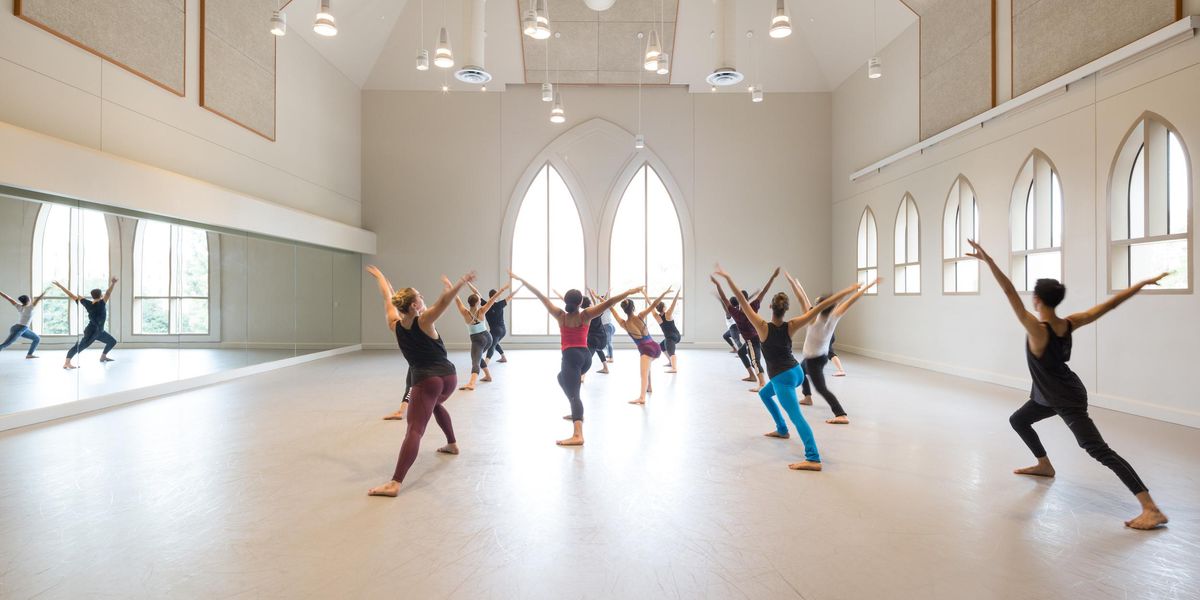Teach-Learn Connection: Learning a Legacy
Alvin Ailey’s “Revelations” residency captures kids’ hearts and minds.
At 1:45 p.m. at Bea Fuller Rogers Middle School in New York City’s Washington Heights neighborhood, high-pitched laughter, chatter, and screams reverberate through the hallways. But inside a small dance studio on the second floor, the atmosphere is different. Two dozen seventh-graders stand silently in a wedge formation, an inverted triangle with one student at the point. Their backs are straight, feet in second position, and arms extended about six inches from their sides. “Heads down, jazz hands,” calls a voice from the front of the room.
Many people would recognize this as the opening pose of “I’ve Been Buked,” the first section of Alvin Ailey’s signature work, Revelations. Teaching this choreography is a core element of the Ailey organization’s “Revelations: An Interdisciplinary Approach,” a pioneering dance-based curriculum implemented in public schools across the country. The initiative launched in 2000 but took on heightened significance this year in honor of the beloved ballet’s 50th anniversary.
“The movement that you do in your body is bigger than your body,” says Nasha Thomas-Schmitt, who is leading today’s session with the help of three assistants. “You gotta think about the space around you. Dance is bigger than that.” The girls and boys watch “Miss Nasha” with rapt attention as she demonstrates a deep plié leaning to the right and then the left while emphasizing, “wide, big, like I have the world.”
A former Ailey dancer, Thomas-Schmitt has been nurturing children’s creativity for more than a decade. As co-director of Ailey Arts in Education Program and national director of AileyCamp, she demands discipline: no talking unless called on, “yes” instead of “yeah.” But despite her no-nonsense demeanor, the vibe is genial. Kids giggle when she refers to a vibrating motion as “Beyoncé” and an arm position as “Egyptian.”
“Alvin had done outreach before it was a buzzword,” Thomas-Schmitt says; it was his idea to use Revelations as a teaching tool. Kathleen Isaac, a dance educator and former Ailey instructor, developed the codified lesson plans, which have since been introduced in many cities, among them Atlanta, Detroit, Washington, DC, and London. The middle-school curriculum gets kids moving, but there is also an academic component. In this interdisciplinary approach, dance is the vehicle through which students learn language arts and social studies.
During a typical five-day residency, young people with no previous dance exposure explore the life and contributions of Alvin Ailey. “We want them to see him as an interesting person, someone they can relate to,” says Thomas-Schmitt. They also examine the historical, cultural, and political themes of Revelations. To help these abstract concepts resonate, students are encouraged to find their own creative voices. For one assignment, the Bea Fuller Rogers kids rewrote the words of the opening spiritual to reflect their experiences. One student replaced “I’ve been buked and I’ve been scorned” with “I’ve been bullied and I’ve been put down.” They also write poetry.
But the most powerful device is the drama and dynamism of the dance itself. The students learn parts of Revelations, then alter the steps with their own ideas. An exercise based on reaching and bending motifs in “I’ve Been Buked” requires pairs of students to come up with 48 counts featuring six distinct elements (reach, bend, move away, come together, turn, reach). They must mirror each other when presenting, which adds another degree of difficulty. After each duet performs, Thomas-Schmitt leads a class assessment. “We talk about the movement quality. Are there patterns? Is it fluid or percussive?”
For many kids, the chance to choreograph is a highlight of the week. “You get to express yourself inside and out,” says 12-year-old Jhonay Allen. “I think of a story or topic I really want to dance about. For angry, I’d probably punch or do sharp stuff.” One group experimented with a peeling motion inspired by a student’s suggestion of plátanos, or plantains. When a new term, like canon, emerges in these sessions, it is added to the “word wall.” (Earlier, when the children wrote what dance means to them on the wall, José Baez, 12, eagerly penned “passion.”)
As the culmination of the residency, students get to watch the Alvin Ailey American Dance Theater perform Revelations live. This has a profound effect on them, says Denise Brown, a teacher at Bea Fuller Rogers. “The athletic strength required is amazing to a child. They want to emulate that.” Her class attended the 2010–2011 New York City Center season, which kicked off a 24-city tour. As the national celebration of Revelations at 50 continues, the residency will travel to St. Louis, Los Angeles, Houston, Detroit, and other locations.
Thomas-Schmitt marvels at the residency’s impact. “It’s a big self-esteem builder,” she says, noting that in the past 10 years she’s seen more participation from boys. Few of her public school students go on to pursue dance professionally, but to her that’s not the point. “Computer scientist or gourmet cook or electrician—everyone has to be in touch with their creative self to develop critical-thinking skills and to problem-solve. And also to enjoy what they do. The arts are tools that help us engage on that level.”
Elaine Stuart has written about dance for
The Wall Street Journal and Time Out New York Kids.
Nasha Thomas-Schmitt teaches
Revelations at Bea Fuller Rogers Middle School. Photo by Rachel Papo




